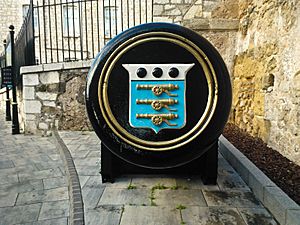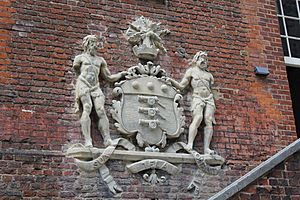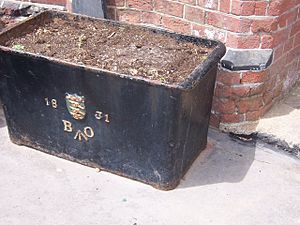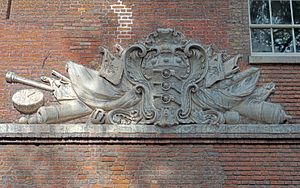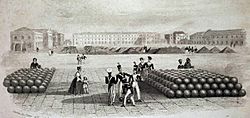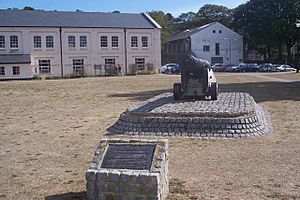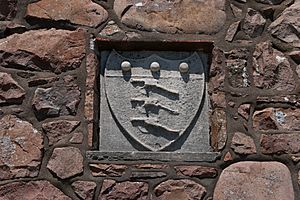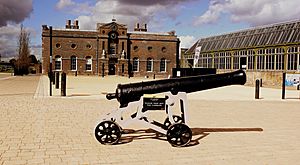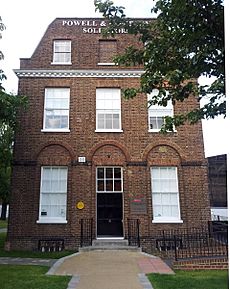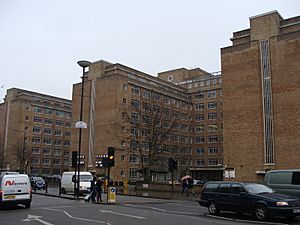Board of Ordnance facts for kids
The Board of Ordnance was an important British government group. It started way back in the Tudor period (when kings and queens like Henry VIII ruled). Its main office was in the famous Tower of London. The Board's main jobs were to look after all the land, storage places, and forts needed to protect Britain and its lands overseas. They also supplied weapons and equipment to both the Army and the Navy.
The Board of Ordnance also managed and created the Artillery and Engineer corps in the 1700s. By the 1800s, it was one of the biggest government departments, second only to the Treasury. The Board existed until 1855. It was closed down because it did a poor job of supplying the Army during the Crimean War.
Contents
How the Board of Ordnance Started
When gunpowder arrived in Europe, it changed how wars were fought. New weapons like cannons and stronger forts appeared. From the 1320s, a person called the 'Keeper of the Privy Wardrobe in the Tower of London' became responsible for getting, storing, and giving out weapons. His office and main weapon storage were in the White Tower. This 'Privy Wardrobe' grew a lot during the Hundred Years' War.
Over the next century, the Privy Wardrobe became less important. By the 1460s, a new group called the Office of Ordnance started at the Tower. This office handled firearms and cannons. It had a Master, a Clerk, and a Yeoman. In the 1540s, during the time of King Henry VIII, the Ordnance Office got bigger. New officers were hired, and their jobs became clearer.
In 1671, the Office of Ordnance took over the work of the Office of Armoury. The Armoury used to handle armor and swords, but its work had started to overlap with the Ordnance Office. Around this time, the Ordnance Office also began to look after the nation's forts. In 1683, King Charles II officially made the management group into the Board of Ordnance. It had five main officers led by the Master-General. They met at least twice a week at the Tower to make decisions.
Who Were the Main Officers?
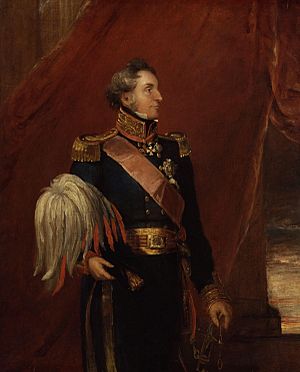
By the mid-1500s, the Master was helped by five 'Principal Officers'. These officers later formed the Board. They included:
- The Master (later Master-General) of the Ordnance: This person was the head of the Board and the leader of the military groups.
- The Lieutenant (later Lieutenant-General) of the Ordnance: This person was the Master's helper and second-in-command.
There were also four department heads:
- The Surveyor (later Surveyor-General) of the Ordnance: In charge of checking quality.
- The Clerk of the Ordnance: In charge of buying things.
- The Storekeeper (later Principal Storekeeper) of the Ordnance: In charge of storing things.
- The Clerk of the Deliveries of the Ordnance: In charge of giving out supplies.
The roles of Master and Clerk of the Ordnance can be traced back to 1414. By 1450, the Master of Ordnance was a permanent job based at the Tower of London.
In 1543, the job of Yeoman of the Ordnance was split into two new roles: the Storekeeper and the Clerk of the Deliveries. The Surveyor of the Ordnance job was also created at this time.
From the 1600s until 1828, the Master-General usually had a seat in the government's top meeting group, the Cabinet. This meant they were the main military advisor to the government. Famous soldiers like Marlborough and Wellington held this important job.
Even though the Master-General and Lieutenant-General were usually soldiers, the Ordnance Office was mostly a civilian group. This changed when the Artillery and Engineer corps were formed in the early 1700s. After creating the Royal Artillery and Royal Engineers, the Board managed both military and civilian staff.
Other Important People
The Ordnance Office had many Clerks to handle its paperwork. Other officials included furbishers (who polished weapons), proofmasters (who tested weapons), and fireworkers (who handled explosives).
Two special jobs were the Master Gunner of England and the Chief Engineer. These were the top technical experts. The Master Gunner job started in 1485, but it ended when the Royal Artillery was formed. The Chief Engineer job began in 1660.
The Treasurer of the Ordnance was another key person, but they weren't on the Board. This job started in 1670. In 1836, it became part of the Paymaster General role.
The Board also had officers in forts and storage areas across Britain and overseas. The main officer in these places was usually the Storekeeper. They reported directly to the Board.
Board of Ordnance Symbols
The Board of Ordnance had its own special Coat of Arms. It first appeared in the 1600s and was officially approved in 1806. It looked like this:
- Shield: A blue shield with three gold cannons pointing up. At the top, a silver band with three black cannonballs.
- Crest: A silver crown with a hand holding a winged, flaming thunderbolt.
- Supporters: Two Cyclops (giant one-eyed creatures). One holds a hammer, the other holds tongs.
- Motto: sua tela tonanti. This means 'To the thunderer his weapons' or 'To the warrior his arms'.
You can still see the old Board's shield on the cap badge of the Royal Logistic Corps today. The crest is on the flag of the Corps of Royal Engineers.
The Broad Arrow Mark
The broad arrow was the Board's special mark, used from the 1600s. It was stamped on guns, papers, buildings, and all kinds of equipment. It showed that the item belonged to the King or Queen. In 1806, the Board ordered its Storekeepers to mark "all descriptions of Ordnance Stores ... with the broad arrow as soon as they shall have been received as fit for His Majesty's Service".
The 'Ordnance Regiment'
In 1685, King James II asked Lord Dartmouth to create a new Ordnance Regiment. This regiment was meant to guard the cannons and other weapons in the Tower of London. It also protected the artillery trains, which moved cannons to battlefields. This new regiment was called 'Our Royal Regiment of Fusiliers'. They used modern flintlock guns instead of older matchlock muskets.
After 1688, the Fusiliers became a regular Infantry regiment (the 7th Foot, later called the Royal Fusiliers (City of London Regiment)). But they kept a base at the Tower. Today, the Tower is still the main office for the Royal Regiment of Fusiliers.
What the Board Did
Storage and Supply: Ordnance Yards
Main Office: The Tower of London
In earlier times, the King's Wardrobe handled weapon storage. Royal palaces, like the Tower of London, were used to store armor, weapons, and gunpowder. When the Office of Ordnance started, the Tower was already the main storage place and stayed the Board's administrative center. Gunpowder was kept in the White Tower until the mid-1800s.
Other weapons and equipment were stored in different buildings within the Tower. From the mid-1500s, larger items were kept in warehouses nearby. Cannons were tested on the 'Old Artillery Ground' to the north.
The New Armouries (built in 1664) stored small arms. The huge Grand Storehouse (built in 1692) was a store and a museum of weapons. Sadly, it was destroyed in a fire in 1841, along with 60,000 items.
By 1806, the Board's staff had grown so much that they moved their main offices to Cumberland House in Pall Mall, London. The Tower was then mostly used for storage.
Main Storage Depots: Woolwich and Weedon
In the mid-1600s, the Board started using land at Woolwich to store and test its guns. This land, called The Warren, was bought in 1671. In 1682, thousands of cannons and cannonballs were moved there from the Tower. From 1688, all new weapons were sent to Woolwich.
The Woolwich Warren (later called the Royal Arsenal) became Britain's main weapon depot and a major manufacturing site.
During the Napoleonic Wars, people worried about attacks on weapon stores from the sea. So, a new Royal Ordnance Depot was built at Weedon Bec in Northamptonshire, far from the coast. It had many storehouses and gunpowder magazines connected to the Grand Union Canal for easy transport.
Distribution Points: Royal Dockyards
The Board set up storage areas near the Royal Dockyards. This made it easy to load guns, ammunition, and powder onto ships for the Navy or for the Army in war zones. These places also supplied weapons for the Dockyard's own defenses.
In the 1500s, the Ordnance Office had smaller branches in Chatham, Deptford, and Woolwich. Later, other major Dockyards got their own special Ordnance Yards. These yards were built next to deep-water docks and had buildings for storage, offices, workshops, and housing for officers. They often had a large central storehouse for gun carriages.
Main Yards in Britain included:
- HM Gun Wharf, Chatham
- Morice Yard, Devonport
- Gunwharf, Portsmouth
- Gun Wharf, Sheerness
- Gun Wharf, Woolwich
Ordnance Yards were also built in overseas colonies. For example, Bermuda's yard, started in the 1830s, is still mostly there. It has magazines and storehouses around a small pool where boats would bring ammunition.
Gunpowder Storage
For gunpowder, the Board often used existing fortified buildings at first, like the Square Tower at Portsmouth. Later, they built special Gunpowder Magazines. These were usually far from towns for safety.
The Tower of London was the main gunpowder store until 1694. Then, a new depot was built at Greenwich Peninsula by the River Thames. This spot was chosen because it was mostly empty marshland and gunpowder barrels arrived by boat. Gunpowder was stored and tested here.
However, local people soon complained about the gunpowder store at Greenwich. So, in 1763, new magazines and a testing house were built further downriver at Purfleet. This was called the Royal Gunpowder Magazine. It became the main place to receive and approve gunpowder from makers before sending it out. The Greenwich magazine was then closed.
Around the same time, gunpowder depots at the Dockyards were improved. New facilities were built at Portsmouth (Priddy's Hard) and Devonport (Keyham Point). These centers grew as gunpowder storage became more complex. In 1850, Devonport's magazine moved to Bull Point. This was the last big building project before the Board closed down.
Other Supplies
The Board of Ordnance always supplied weapons and ammunition to the Army and Navy. From 1822, it also became responsible for getting and storing other items for the Army. This included tents and camp equipment. Later, in 1834, the Board also took on the job of providing food, coal, and candles for troops in Britain, and forage (food for horses) for cavalry.
Manufacturing: Ordnance Factories
Before the 1700s, the Board usually bought weapons from private companies. Small arms came from places like the Birmingham Gun Quarter. Gunpowder came from Faversham and later Waltham Abbey. Cannons were bought from iron foundries. Over time, the Board started to set up or buy its own factories.
Artillery Manufacturing
The Board's main manufacturing site was the Royal Arsenal in Woolwich. Guns had been stored and tested there since the mid-1600s. It grew into a huge factory making:
- Shells, projectiles, and propellants (Royal Laboratory, started 1695).
- Cannons and other artillery (Royal Brass Foundry, started 1717).
- Gun carriages and other related items (Royal Carriage Works, started 1803).
Gunpowder Manufacturing
Gunpowder making was usually kept separate. In the 1700s, the Board started buying private gunpowder mills:
- Faversham became the Royal Powder Mill in 1759.
- Waltham Abbey became the Royal Gunpowder Factory in 1787.
- In Ireland, the Ballincollig Royal Gunpowder Mills were bought in 1805.
The Board stopped making gunpowder at Ballincollig in 1815, and Faversham was sold back to private owners. But Waltham Abbey stayed a government factory until 1991.
Small Arms Manufacturing
The Board started making small arms at Tower Wharf in 1804. It then moved to Lewisham (Royal Manufactory of Small Arms, 1807) and later to Enfield (Royal Small Arms Factory, opened 1816). The Enfield factory made weapons until it closed in 1988.
Forts and Fortifications
From the mid-1600s, the Board of Ordnance became involved in designing, building, and maintaining forts and other military buildings. The Chief Engineer was in charge of drawing up plans and checking existing defenses. In 1802, the Inspector General of Fortifications took over this work.
Barracks
The Board was also responsible for building and managing barracks (buildings where soldiers live). This was except for a 30-year period (1792-1822) when a separate Barrack Office handled it. Before this, barracks were rare in Britain, mostly found inside fortified areas. After the French Revolution, many barracks were built. But problems with the Barrack Office led to the Board of Ordnance taking back responsibility for barracks after the Napoleonic Wars.
Personnel: The Ordnance Corps
The Board of Ordnance created several special military groups, or Corps, to do its work. These included the Royal Artillery and the Royal Engineers. These Corps were under the Board of Ordnance, not the War Office, until the Board closed in 1855. Their officers were given their jobs by the Master-General of the Ordnance, not the Army's Commander-in-Chief.
Royal Artillery
In 1716, the Duke of Marlborough, as Master General of the Ordnance, created two permanent companies of field artillery. They were based at the Warren (Royal Arsenal) in Woolwich. Before this, artillery groups were put together only when needed for a battle. The new artillery companies (which became the Royal Regiment of Artillery in 1722) provided troops for moving cannons. Soon, they also provided guns for forts and garrisons across the country and the British Empire. In 1793, the Royal Horse Artillery was formed to support the Cavalry.
Royal Engineers
From the beginning, the Board had military engineers and surveyors to build and improve harbors and forts. In 1716, a Corps of Engineers was founded by the Board at Woolwich. These Engineers (called Royal Engineers from 1787) designed, built, and maintained defenses and other military sites. They also worked on large civilian projects sometimes. Civilian workers helped them, and these workers became military in 1787, called the Royal Military Artificers (later Royal Sappers and Miners). After the Board closed, the Sappers and Miners joined the Royal Engineers.
Other Corps
A Field Train Department was set up in 1792. It was in charge of supplying small arms and ammunition to front-line troops. After the Board closed, this department became part of the Royal Army Ordnance Corps.
In 1796, a Corps of Royal Artillery Drivers was created to provide horses and drivers for moving field guns. Before this, civilian drivers were used. In 1822, the Drivers joined the Royal Artillery.
The Corps of Royal Military Surveyors and Draftsmen was a military group under the Board, formed in 1800. It helped with the work of the Ordnance Survey (mapmaking).
The Ordnance Medical Department was formed in 1801 to provide surgeons for the Artillery and Engineer corps. It was merged into the Army Medical Department in 1853.
In 1796, Edward Coleman became the Veterinary Surgeon to the Board. He trained other vets to care for Artillery and Engineer horses. In 1805, he set up a Veterinary Establishment in Woolwich, which became a hospital and research center for animal care.
Education and Training
The Board of Ordnance believed in giving its future officers a good scientific and military education. While the Army didn't require formal military education for its officers, the Board quickly set up training for its artillery and engineer cadets.
The Royal Military Academy
In 1720, there were plans to create an 'academy' at Woolwich. On April 30, 1741, the Royal Military Academy was officially opened there. It was a place where young 'gentlemen cadets' learned about gunnery, fortifications, math, and French. By 1764, it was a unique place that taught writing, arithmetic, algebra, Latin, French, math, and military skills like attacking and defending forts. It also taught gentlemanly skills like dancing and fencing. The Academy later moved to new buildings on Woolwich Common in 1806. In 1946, it joined with another college to form the Royal Military Academy Sandhurst.
Specialist Training
The Royal Military Repository was set up in 1778 at Woolwich to teach practical and theoretical gunnery to officers and soldiers. It also moved to Woolwich Common in the early 1800s. The Royal Engineer Establishment was founded by the Board in Chatham in 1812. It provided advanced training for Engineer officers and was later renamed the School of Military Engineering.
Other Important Activities
Mapmaking: The Ordnance Survey
The Board had a department that surveyed land and made maps as part of its job to maintain harbors and forts. This department grew into the Ordnance Survey, which is still Britain's national mapping agency today. Its main offices were in the Tower of London. Here, surveyors and mapmakers worked, and young cadets were trained in math and drawing. In 1841, a fire caused the Survey to move to Southampton. After the Board closed, it became part of the War Department.
The Geological Survey
The Ordnance Geological Survey, the world's first national geological survey (studying rocks and land), was started by the Board in 1835. Ten years later, it moved to another government department. Since 1984, it has been known as the British Geological Survey and still works as a national research and advice group.
The Global Magnetic Survey
In 1839, the government supported Major Edward Sabine to set up four special observatories around the world. These observatories measured Earth's magnetism and weather. Three of them were staffed by Artillery officers under the Board of Ordnance. Measurements were taken every two hours, day and night, at the exact same time in all four places. The results were sent to Sabine at Woolwich. This project helped scientists understand Earth's magnetic field.
The Royal Observatory, Greenwich
In 1675, the job of Astronomer Royal was created. The Board of Ordnance was ordered to pay the Astronomer's salary and build a Royal Observatory in Greenwich. This was one of the first times the government funded science! The money came from selling 'old or decayed gunpowder'. The Board funded the Observatory until 1818, when the Admiralty took over.
The End of the Board
| Act of Parliament | |

|
|
| Long title | An Act for transferring to One of Her Majesty's Principal Secretaries of State the Powers and Estates vested in the Principal Officers of the Ordnance. |
|---|---|
| Citation | 18 & 19 Vict. c. 117 |
| Dates | |
| Royal assent | 14 August 1855 |
|
Status: Current legislation
|
|
| Text of statute as originally enacted | |
| Text of the Ordnance Board Transfer Act 1855 as in force today (including any amendments) within the United Kingdom, from legislation.gov.uk | |
The Ordnance Board Transfer Act 1855 officially moved all the Board's powers and responsibilities to the 'Secretary of State for the War Department'. This included looking after stores, land, contracts, surveys, defenses, and manufacturing, along with all the staff. The Board's old offices in Pall Mall became the main office for a much larger War Office. The jobs of Master General, Lieutenant-General, and Principal Storekeeper were ended. The Royal Artillery and Royal Engineers were moved from the Master General's command to the Commander-in-Chief of the Forces. Both groups then became a full part of the British Army.
Why the Board Was Ended
The main reason the Board was closed was the Crimean War. There were huge problems with getting supplies to the soldiers, especially during the cold Russian winter of 1854. These problems were widely reported and led to the government falling in January 1855. The new government quickly started to reorganize the military.
Even before the Crimean War, there were efforts to reduce the Board's power. In 1830, the number of main officers was cut. This might have made the problems worse.
The reasons for the supply failures in Crimea were complicated. The British Army's management in the 1850s was messy and inefficient. Many different officials and groups were in charge of military matters, and they didn't work together well. Also, after 40 years of peace, the army and its support services were not ready for war. For example, getting food and fuel to troops overseas was handled by the Commissariat, a part of the Treasury that wasn't used to wartime. The Army's land transport group had also been ended in 1832 to save money.
Much of the blame at the time fell on Field Marshal Lord Raglan, the commander of the British army in Crimea. He was also the Master-General of the Ordnance. His absence from Britain during the war left a gap in leadership at the Board.
However, the Commander-in-Chief Lord Hardinge spoke positively about the Board's work in 1855. He said the Board had handled the military challenges well and quickly fixed problems.
Ultimately, the Crimean War showed problems across many departments and confusing command structures. The closing of the Board of Ordnance was one of many big military changes in Britain over the next 50 years.
What Happened Next
After the Board closed, a new Under Secretary was appointed in 1856 to take over the duties of the Clerk of the Ordnance. Several new departments were formed, including a Director General of Stores and a Director General of Contracts. In 1857, the network of Storekeepers and Clerks became the Military Store Department.
Because there was a long-standing distrust of a large standing army in Britain, the Military Store Department (which held many weapons) remained under civilian control. Over time, many organizational changes happened to combine the different jobs that used to belong to the Board of Ordnance and other groups.
The Ordnance Board in the 1900s
About 50 years after the old Board closed, a new group called the Ordnance Board was created within the War Office. This happened after problems with equipping the British Army during the Second Boer War. The new Board was a committee of weapons experts. Their job was to advise the Army Council on the safety and approval of weapons.
This new board came from an earlier committee formed by the old Board of Ordnance in 1805. This committee helped decide on new inventions and improvements for artillery.
The Ordnance Committee was reformed in 1881. It was renamed the 'Ordnance Board' in 1908. It changed names again to 'Ordnance Committee' in 1915 (during World War I, it was part of the Ministry of Munitions). It became the 'Ordnance Board' again in 1939 (during World War II, it was part of the Ministry of Supply).
Until 1939, the Ordnance Board was based at the Royal Arsenal in Verbruggen House. It worked closely with other departments that tested and designed weapons. When World War II started, the Board moved to Chislehurst and then to Charles House in Kensington in 1950.
After the war, the Ordnance Board continued to give expert advice on developing and designing weapons, ammunition, and explosives. The leaders of the Board rotated between the three military services (Army, Navy, Air Force).
The Ordnance Board existed within the Ministry of Defence until the mid-1990s. It was then renamed the Defence Ordnance Safety Group.
Notable Staff
- Paul Sandby (1731-1809), a famous water-color artist, was one of its map-makers in the 1700s.
- Captain George Manby FRS (1765-1854), who invented the Manby mortar (a device for rescuing people from shipwrecks), was also a barrack-master.
- John Wilson (1782–1866) was a Clerk of Works for the Board of Ordnance. He supervised work on barracks in Guernsey around 1813. He later became a well-known architect on the island.
See also
- List of Masters-General from 1415
- The Royal Artillery and the Royal Engineers, both started by the Board of Ordnance.
- The Royal Military Academy, Woolwich, set up by the Board to train its officers.
- Royal Ordnance Factories
- Ordnance Survey
- Ordnance yards and other facilities, including Gunpowder magazines.
- Tower of London, the Board's headquarters.
- Woolwich Royal Arsenal (a key Ordnance facility).
- Broad arrow
- Anthony Roll


